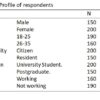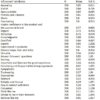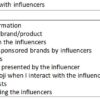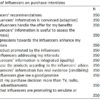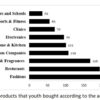© Media Watch | Volume XII | Issue No. III | 2021
ISSN 0976-0911 | E-ISSN 2249-8818
DOI: 10.15655/mw/2021/v12i3/165405
Article | Open Select
Impact of Social Media Influencer Marketing On Youth Purchase Intentions in UAE
Ahmed Farouk Radwan1, Sheren Ali Mousa2,
MervatMedhat Mohamed3, & Enaam Youssef Mohammed Youssef4
1University of Sharjah, UAE
2Helwan University, Egypt
3,4 Ajman University, UAE
Received: 22 June 2021| Accepted: 30 July 2021|Published: 4 August 2021
Abstract
The study analyses how youth perceive social media Influencers and whether they affect their purchasing intentions and buying decisions. It also measures influencers’ attractiveness, expertise, and trustworthiness while communicating with consumers. In addition, the study explores the types of digital interaction with influencers, measures the impact of their online marketing activities on purchasing intentions, and finds differences between youth demographic segments. A total of 350 youth participants in the United Arab Emirates (UAE) completed an online survey evaluating influencers’ characteristics, promotional videos, types of youth interaction with their content, and their impacts on purchasing intentions. The findings show that youth in UAE consider that influencers have positive personal appeals, traits, and information support to attract their followers and encourage them to purchase. Furthermore, the results reveal that influencers push youth to search for more information about the products and visit marketers’ websites. Influencers’ social media activities also affect youth’s interests, desires, and purchase intentions by helping them assess the products.
Keywords: Influencers, social media, online marketing, purchase intentions, youth, UAE
Introduction
Social media undoubtedly has changed the way people interact and communicate, thus presenting new opportunities and challenges in marketing. Social media became a marketing communication hub for companies, sellers, advertisers, and customers. By those platforms, marketers try to shape customers’ brand perceptions and admirations and affect their purchase decisions. In addition, consumers are increasingly using digital platforms to search for information about products and services (Evans et al., 2017; Sudha & Sheena, 2017; Byrne, Kearney & MacEvilly, 2017).
The global influencer marketing platform was valued at USD 148.04 million in 2019 and is expected to reach USD 337.74 million by 2027. Influencer marketing is one of the most promising fields of digital marketing processes. It has opened up a new horizon for brands and businesses to connect with audiences. With the increasing adoption of intelligent technologies, brands strategically approach their customers to build strong relationships. The influencer-marketing platform has a sustainable future in many fields, including the healthcare sector, such as lifestyle and wellness programs and medical care (Reportlinker, 2019).
In the United Arab Emirates, e-commerce sales are estimated to grow by an average of 23% annually between 2018 and 2022. Shopping via mobile devices, personal computers, tablets, and connected devices is now a part of consumers’ everyday lives. They can use newer payment methods introduced by various providers with a safe, convenient method. The consumer demographic in the UAE consists of a young population with high Internet and social media usage. Almost 63% of Internet users in the UAE shop online. These people are more likely than other consumers to spend time online; they use their smartphones to follow their favorite influencers (The UAE e-Commerce Landscape, 2019).
In addition to that, the UAE has a favorable environment for social media e-marketing with the advantages of digital adoption, consumer demographic, infrastructure, and policies. The UAE’s total population is 9.83 million, whereas the active Internet users are 9.73 m., the mobile Internet users are 9.6 m., and the active social media accounts are 9.53 m. Data on social media consumption in UAE reveals that Facebook is the preferred platform for social media users, with 8 million active users. The second platform is Instagram, with 3.5 million users. Twitter, Snapchat, and LinkedIn are ranked from the third to the fifth. With a daily average of 2.57 hours people spend on social media, it has become an essential daily UAE activity (Allison, 2020).
On the other hand, 94% percent of brands based in the UAE believe in social media e-marketing and use influencers significantly for business promotion. Dubai-based PR agency BPG’s reports showed that 71 % of UAE residents between 18-40 years of age are happy to take advice online before purchasing. Furthermore, the survey found that fashion, beauty, and food are the most preferred areas where UAE people are likely to follow social media influencers for recommendations (Social Media Influencers’ Survey, BPG, 2019). To protect the social values of the UAE, in 2018, UAE National Media Council (NMC) issued a set of regulations that governed online activities, including e-commerce. Under the new regulations, influencers using social media to promote brands and businesses will need to get a media license issued by the NMC (NMC, 2021). Based on these characteristics, the study aims at exploring the effect of social media influencers on youth purchase intentions in UAE by identifying the youth perception of influencers marketing, assessing the impact of influencers marketing on purchase decisions, exploring youth opinions about influencers posts on social media, and discovering brands that youth depend on influencers to get information about them.
Literature Review
Influencer Marketing
Social media has become an essential digital platform for advertisers and marketers who act to reach their consumers in recent years. Influencer marketing could be considered as a part of marketing communication campaigns. In a competitive market, influencer marketing offers alternatives for brands and companies to reach consumers (Evans et al., 2017). Influencer marketing functionalizes individuals’ or opinion leaders’ impact to drive brand consumers’ awareness or purchasing decisions (Khamis, Ang& Welling, 2017). It is also defined to promote or endorse a brand or product on social media platforms by influencers (Veirman et al., 2017). Influencer marketing is also defined as a process in which a brand identifies and activates persons with significant influence over its target audience and markets to promote and raise sales. Influencer marketing is a word-of-mouth marketing concept focusing on a social context and relationship building (Sudha & Sheena, 2017). Influencer marketing trend has established partnerships with influential people to increase brands’ visibility on social media (Abidin, 2016). The digital equivalent of word-of-mouth marketing focuses on using key leaders or influencers to drive a brand’s message to the customers and change their buying behaviors (Byrne, Kearney & MacEvilly, 2017).
Influencer marketing has four main steps: (i) identifying influencers and rating them according to their importance, (ii) raising brand awareness of influencers’ followers, (iii) raising awareness of target markets through influencers, and (iv) turning influencers into brand consumers’ perceptions (Ranga & Sharma, 2014). Brown and Hayes (2008) stated that there are three stages of influencer marketing: (i) raising brand awareness among followers, (ii) raising brand awareness among target consumers, and (iii) transforming influencers into brand advocates.
Influencer Marketing Platform
Influencer marketing on social media is one of the new channels for brands to connect with consumers more directly and socially in their everyday life. Social media influencer marketing has proved a high success in engaging and targeting new audiences – beyond their interest, demographic, or location (Gallaugher & Ransbotham, 2010; Tsimonis & Dimitriadis, 2014). Recently the most powerful brands consider social media Influencers are their brand ambassadors. Consumers are looking at fellow consumers to inform their purchasing decisions or lifestyle. Companies are dynamically using influencers as a third-party voice in their advertising campaigns. Influencers through social networks reach the end-consumers directly, at a low cost and timely manner. Companies use influencers’ social media communities, openness with consumers’ attitudes, clout, and credibility (Buyer, 2016). The idea of influencer characteristics like credibility, interactivity, and trust is the main aspect of influencers’ marketing (Singh & Banerjee, 2018).
Glucksman’s (2017) study found that social media influencers’ success does not rely solely on their follower count but their ability to influence followers through authenticity, confidence, and interactivity to create a connection between the followers and the brand. The research also noted that social media influencers are marketing the feeling by their impression. Authenticity and trust are the foremost practical influencer attributes and highly contested terms that should be studied (Dhanesh & Duthler, 2019). Influencers are powerful promotional tools due to their trend, ability, and influence on consumption. Social media platforms manage the search, selection, and relationships between brands and influencers (Berne & Marzo, 2020). Singh and Banerjee (2019) on celebrity influencers’ credibility reveal that celebrity influences consumers’ attitudes towards the brand and purchase intention; both brand attitude and advertisement attitude built on celebrity credibility significantly influence.
Influencers Attributes
Social media Influencers are individuals or celebrities who have amassed large numbers of followers on their accounts as they post attractive content, videos, and photos that highlight their lifestyle, preferences, and merchandise preferences (Cotter, 2019). The growth of smartphone applications for content and image sharing has fueled the rise of Influencers’ impact among their followers by sharing experiences in the areas in which they claim expertise (Argyris et al., 2020). Social media has brought a new type of celebrity, creates a self-presentation, and accomplishes a creation image used to attract the attention of a large number of followers (Marwick, 2015; Khamis, Ang, & Welling, 2017). Influencers create visually attractive content in many niches, including health, beauty, fitness, fashion, and life coaching (Lueck, 2015).
Chetioui, Benlafqih, and Lebdaoui (2020) illustrated that influencers’ attitudes positively impact brand attitude and purchase intention. Perceived credibility, trust, expertise, and congruence positively impact attitudes toward them. Stubb, Nystrom and Colliander (2019) indicated that the credibility of the influencer is significantly higher in affecting the consumers’ attitudes and providing evidence toward the new products or the products they do not have experience about, thus more than the well-known products they are familiar with and have a previous brand and product experiences. Barbu and Cmeciu (2019) highlighted that sympathy, trustworthiness, expertise, and similarity are the main elements of social media influencers’ credibility. Wellman et al. (2020) discussed the ethical guidelines that the influencers work within them. They referred to the importance of understanding the principles guiding sponsored content and brands and the necessity of being faithful with the users. Influencers textually and visually exhibit their personal daily lives to attract and maintain them; they may also engage the followers in their posts that promote many brands (Chae, 2018).
Purchase Intentions
Many studies investigate the factors affecting purchase intentions. Ma, Littrell, and Niehm (2012); Lee (2014); and Abner (2019) examined different types of cognitive and behavioural factors. Erkan and Evans (2018) defined four factors that might affect consumers’ purchase intentions: information quality, Information credibility, usefulness, and information adoption. Gazley, Hunt, and McLaren (2015) mentioned the message type, customization, and permission, as factors leading the consumers’ attitudes to enhance the likelihood, willingness, and probability of purchase intentions.
Some Arab countries have witnessed discussions on the role of influencers, celebrities, and e-word-of-mouth (e-WOM) in purchasing intentions. Alnasor et al. (2016) indicated that the corporate promotional content in its social media account affects the purchase intention. Khatab and Ragab (2014) and Abdel Al (2015)indicated that source expertise, similarity, and trust positively affect the online purchase intention of Egyptian youth. Al-Dahrawy’s (2019) study on the attitudes of Arab youth towards marketing through social media found a positive relationship between purchase intentions and attitudes towards influencers. The researcher has stated that attractiveness, interaction, experience, and credibility affect youth purchase decisions. Paset (2020) showed the positive impact of purchase intention, brand awareness, and e-WOM.
Electronic Word of Mouth and Purchase Attitude
Behaviour can be changed in social networks context by direct experience of observing others attitudes, enabling information flow and behavioral change adoption (Liu et al., 2017). This increases the significant effect of influencers on their followers. E-WOM has become an active communication tool in influencing the consumer decision-making process. eWOM refers to potential, actual, and former customers’ positive or negative opinions towards a product or brand via the Internet. E-WOM is a new casual, easy, and more continuous information service source (Joshi & Singh, 2017). It is a powerful source of information that influences consumers’ intention to purchase by building their perception towards a product or service (Steffes & Burgee, 2009). E-WOM creates communication between a person, a non-commercial interaction between sender and receiver regarding a product, brand, or service (Yolanda & Ngai, 2011). Most Internet and social media users who join online communities have an online trust in e-WOM; usually, they and other consumers share their knowledge and product or service experiences (Flavián & Guinalíu, 2005; Zhao & Lavin, 2012; Hali & Khani, 2013). Thus, social media influencers form consumers’ opinions on products and services (Chetioui, Benlafqih, & Lebdaoui, 2020; Joshi & Singh, 2017). So, it is in the interest of the company as well as the influencer to keep online conversations positive and persuade other consumers to try products in a way that makes it feel as if the decision to make the purchase was in the interest of the consumer as opposed to the persuasion of the influencer (Lee & Youn,2009).
This study examines the impact of influencers’ marketing strategy on consumer purchase intention in the UAE. It also explores the factors that influence the youth in their response to the influencers’ promotional activities on social media. For this study, the researchers set the following objectives and research questions:
Research Objectives
(i) To identify how the youth perceive and evaluate the social media influencers,
(ii) To assess the effect of social media marketing influencers on youth purchase intentions and decisions, and
(iii) To explore how the youth evaluate the promotional content that influencers post on social media.
Research Questions
RQ1: How does the youth perceive and evaluate the attributes of social media influencers?
RQ2: How do the marketing influencers’ promotional activities affect the youth purchase intentions?
RQ3: Are there significant differences among the youth demographic variables in their marketing influencers’ evaluation, interaction, and affecting?
RQ4: Are there significant correlations between influencer attributes, interaction, and their impact on purchase intentions and buying decisions?
RQ5: How does the youth evaluate the influencers’ promotional videos?
RQ6: What are the products that influencers most likely have the ability to affect the youth buying decisions?
Methodology
The researchers applied the survey method to collect the information using online resources. A stratified probability sampling method was applied to select the respondents from the UAE community. The survey instrument was a set of questionnaires aimed to collect data from respondents. The respondents were requested to answer five questions relating to the study objectives. Three experts in communication and business administration were engaged to ensure the questionnaires’ validity and reliability. As a result, Cronbach’s alpha coefficients of the research questions are higher than 0.70, which is acceptable in most social science research.
All items measuring RQ1: Youth’s perception of influencers marketing were adapted on a 5-point Likert scale ranging from (1) Strongly Disagree to (7) Strongly Agree (a = 0.000).
All items measuring RQ2: The types of youth interaction with the influencer’s posts were adapted on a 3-point Likert scale ranging from (1) Rarely to (3) Always (a = 0.000).
All items measuring RQ5: How influencers affect youth’s purchase intention was adapted on a 5-point Likert scale ranging from (1) Strongly Disagree to (7) Strongly Agree (a = 0.000).
All items measuring RQ6: How youth describe the influencer’s videos were adapted on a 3-point Likert scale ranging from (1) Rarely to (3) Always (a = 0.000).
We used Survey Monkey and SPSS.26 software to analyze the surveyed data of 350 participants (57.1% females and 42.9% males). Table 1 presents the profiles of the respondents.
Results
Table 2 shows the sample description of the attributes of social media influencers in marketing. The attributes are divided into three categories based on Mean values. The first category of attributes, which have Mean values above 3.7, is Appealing, Stylish, Approachable, Friendly and Likeable, Warm, Fascinating, Inspire confidence in the product and the sponsored brand, Elegant, and Attractive. The second category of attributes which have the Mean values ranging from (3.5 to less than 3.7) is: Knowledgeable, Qualified, Experts, experienced about products, Sincere image, text, and video, Valuable, Answer followers’ questions, Exciting, Important and illustrate the great experience, and Convincing and Supported by solid arguments. The third category of attributes which have Mean values ranging from (3 to less than 3.5) is: Sympathetic, Trustworthy, Dependable, Relevant, Reliable and Honest, Easy to contact with them, Competent, think like me, Similar to me in their interests, and Behaves like me. Finally, the last characteristic that can be added to that category (Mean = 2.95) is Like me in personality.
Most attributes described by social media influencers in online marketing are related to their formality, public image, or the way they appear on social media. The second category is related to knowledge, information, communication, interactive and persuasive abilities. In contrast, the third category described their attributes of being trusted and similar with their followers.
Table 3 shows the Mean values of youth interactions with influencers, and the effects of influencers on purchase are low. Maximum interaction was “I seek further product information” (Mean= 2.07), indicate that searching for additional information is more important than other types of exchange, such as direct interaction with influencers. The second type of interaction was “I remember the sponsored brand/product” (Mean=1.95), reflecting the importance of the influencers’ marketing for the brand/product. Whereas “I interact very actively with the influencers” (Mean=1.94), again shows the importance of using influences to convince consumers. The fourth type assures the results of searching information as it was “I visit the websites of the sponsored brands by influencers” (Mean=1.96).
Table 4 shows that the respondents’ purchase intentions are mostly determined by good recommendations and useful information from influencers that help respondents evaluate the products. The Mean values ranged from 3.22 to 3.26. This is followed by effects on purchase decisions, positive impressions, addressing interests, and searching for the products (Mean values ranged from 3.17 to 3.20). Finally, the probability of purchasing, discovering the sincerity of marketing promises, preferring the influencers’ marketing more than other tools, and imitation comes on the third type of effect. In this category, the mean values ranged from 2.6 to 3.11.
The researchers conducted a t-test to determine a significant difference between sample demographic groups, such as evaluating influencer attributes, interacting with influencers, and affecting purchase intentions (Table 5).
Findings in Table 5 shows that there are significant differences among sample segments:
Influencers’ Attributes
(i) Significant differences were found between males and females in perceiving the most important influences attributes (p = 0.00) in favor of males (Mean=25.2).
(ii) Significant differences were found in perceiving influencer attributes (p = 0.00), according to the working status (working/non-working) in favor of who is working (M=23.7).
(iii) No significant differences were found between the segments of age, education, and nationality in perceiving the attributes of the influencer
Interacting with Influencers
(i) Significant differences between citizens and residents in interacting with influencers (p=0.00).
(ii) No significant differences were found between the segments of sex, age, education, and work status in interacting with influencers.
Influencers on Purchase Intentions
(i) Significant differences were found between males and females affected by the influencers’ purchase intentions (p=0.00).
(ii) Significant differences were found between those working and those not affected by the influencers’ purchase intentions (p=0.00).
(iii) Significant differences were found between citizens and residents affected by the influencers’ purchase intentions (p=0.015).
(iv) No significant differences were found between age and education segments affected by the influencers’ purchase intentions.
The researchers conducted the Pearson correlation coefficient to measure the strength of a linear association between youth evaluation towards influencer attributes, youth interaction with influencers, and effects of influencers on purchase intentions. The results showed that:
Strong positive significant correlation between youth evaluation towards influencer attributes and their interaction with the influencers (p=0.00, r=0.74)
Strong positive significant correlation between youth evaluation towards influencer attributes and their purchase intentions for the products/brands (p=0.00, r=0.73)
Strong positive significant correlation between respondents interaction with influencers and their purchase intentions of the products/brands (p=0.00, r=0.68)
This indicates that the positive perception and evaluation towards the influencers affect the youth interaction and positively affect the youth purchase intentions. The study found that the respondents describe the influencers’ videos in two categories. One is related to the content and design, with the Mean value ranging from 2.03 to 2.08. It includes Provide up-to-date information, Fun/Entertaining, Exciting, Informative, Simple, Enjoyable. The second category is related to its ability to convince and influence, whose Mean values range from 1.8 to 1.98. It includes: Believable, Enthusiasm and Inspirational, Delightful, Credible Trustworthy, Reliable, Accurate. According to influencers’ advice, the youth’s most preferred products category is fashion, restaurants, and beauty and fragrances. Figure 1 indicates how the influencers affect the purchasing intentions of goods and services ranging from entertainment to education.
Discussions and Conclusion
Influencer marketing has become one of the marketing strategies that marketers use to promote brands. Social media influencers have a powerful impact on consumers, especially on the young generation. They give opinions, recommendations about brands and products. Marketing agencies and promotional departments use influencers for mentions, reviews, and suggestions to promote their goods and services and build relationships with their target audience. The findings of Aaron and Breuer (2020), Deshbhag and Mohan (2020), Wiedmann and Mettenheim (2020) revealed that the importance of influencers in impacting consumers’ buying decisions through their communication skills, online social presence, and sharing their lived experiences and opinions. Furthermore, the study revealed the importance of interactivity between consumers and influencers, making brands accessible to consumers and helping in choosing the right product. Lin et al. (2020) also assured that interactivity is positively related to influencers’ authenticity and emotional attachment and directly affects brand trust.
Our study results found that influencers’ marketing on social media plays a major role in promoting goods and services, especially lifestyle. They produce text messages, videos, live streams, live chat, and stories and promote brands by displaying features, telling stories, providing advice and suggestions. As a result, influencers have become an essential viable solution and strategy and give many tools in promoting products through a wide range of multiple digital platforms. In addition, they influence the intent of the purchase decision on the youth.
Belanche, Flavián, and Sánchez (2020) found that influencers encourage their followers to search for information about promoted brands and products. However, it depends on consumer involvement with products as it helps raise their intentions to interact with influencers and look for information. Taillon et al. (2020); Pick (2020); and Woodroof et al. (2020); Glucksman (2017); Jun and Yi (2020); Chetioui, Benlafqih, and Lebdaoui (2020); Bochenek (2019); and Han et al.’s (2020) studies have already proved the influencers’ role as attractive persons shaping up the purchase decisions by their credibility, attractiveness, experience and trustworthiness intentions. Furthermore, the study demonstrates that influencers’ posts and videos contribute as instruments for word-of-mouth marketing and enhance the attractiveness and likeability of products and help consumers evaluate their purchase preferences.
Social media marketing influencers have a prominent role in promoting brands in a diversified society with a stable and growing economy and business. Social media marketing influencers have a significant impact on youth’s purchase intentions and decisions in the UAE. They participate in building the brand image and passing on information about the products and services. Results show that the youth engage with social media influencers, connecting with them when searching for products. Furthermore, the study reveals that influencers are reliable in influencing the purchase intentions and decisions of the youth. The results could also serve as supporting systems while deciding the marketing brand’s strategies and services in mapping the influencers’ requirements that should be fulfilled.
Funding: The author(s) received no financial support for the research, authorship, and/or publication of this article.
Conflict of interest: The author(s) declared no potential conflicts of interest concerning the research, authorship, and/or publication of this article.
References
Aaron, F., & Breuer C. (2020). How the Type of Sports-Related Endorser Influences Consumers’ Purchase Intentions. International Journal of Sports Marketing and Sponsorship. doi.org/10.1108/IJSMS-01-2020-0009.
Abdel Al, M. (2015). The Impact of the Word Spoken Electronically on Social Media Sites on Young People’s Intentions to Buy Online. The Egyptian Journal of Business Studies, 39 (3),1–75. search.mandumah.com/Record/717801.
Abidin, C. (2016). Visibility Labour: Engaging with Influencers. Fashion Brands and Advertorial Campaigns on Instagram. Media International Australia, 161 (1), 86–100. doi.org/10.1177/1329878X16665177.
Abner, M. (2019). “Effects of Social Media, Electronic Word-of-Mouth, and Price on US Female Consumers’ Attitude toward Purchase and Purchase Intention of Ethical Apparel.” Iowa State University, Dissertation. https://lib.dr.iastate.edu/etd/16950/.
Al-Dahrawi, M. (2019). Attitudes of Arab Youth towards Marketing through Social Media Celebrities, Influence Marketing, and Its Relationship to Purchasing Behavior: A Field Study The Arab Journal of Media and Communication Research, 27, 158-225. www.search.mandumah.com/Record/1027518.
Allison, A. (2020). Crowd Analyzer’s ‘State of Social Media 2020’ Report Reveals Evolving Consumer Behaviors in Middle East. https://campaignme.com.
Alnasor, H., Almnaserah, A., & Alzyadat M. (2016). The Impact of Social Media Marketing on Purchase Intention in Jordan. Jordan Journal of Business Administration, 12 (3), 519-30. http://platform.almanhal.com.uoseresources.remotexs.xyz/Reader/Article/96614.
Argyris, A., Wang, Z., Kim, Y., & Yin, Z. (2020). The Effects of Visual Congruence on Increasing Consumers’ Brand Engagement: An Empirical Investigation of Influencer Marketing on Instagram Using Deep-Learning Algorithms for Automatic Image Classification. Computers in Human Behavior, 112, 106443. doi.org/https://doi.org/10.1016/j.chb.2020.106443.
Barbu, R., & Cmeciu, C. (2019). Crisis Communication in Romania and Social Media Influencers and Followers. Case Study: Patient’s Death at the Sanador Hospital. Journal of Media Research, 12 (3), 5-17. doi.org/10.24193/jmr.35.1.
Belanche, D., Flavian, M., Sanchez, S.I. (2020). Followers’ Reactions to Influencers’ Instagram Posts. Spanish Journal of Marketing – ESIC, 24 (1), 37–54. doi.org/10.1108/SJME-11-2019-0100.
Berne-Manero, B., & Marzo-Navarro, M., (2020). Exploring How Influencer and Relationship Marketing Serve Corporate Sustainability. Sustainability,12 (11): 4392. doi.org/https://doi.org/10.3390/su12114392.
Bochenek, M. (2019). Connecting with the Right Audiences for a Better Impact – Imperatives of the Influencer Marketing. In Advocacy and Organizational Engagement, 91–110. doi.org/10.1108/978-1-78973-437-920191006.
BPG Group. (2019). Social Media Influencers’ Survey. https://www.bpggroup.com/social-media-influencers-survey.
Brown, D., & Hayes, N. (2008). Influencer Marketing: Who Really Influences Your Customers? Newyork: Butterworth-Heinemann.
Buyer, L. (2016). PR Under the Influence: Why Influencer Marketing Is All the Buzz. Social PR Chat. https://socialprchat.com/pr-under-the-influence-why-influencer-marketing-is-all-the-buzz/.
Byrne, E., Kearney, J., & Macevilly, C. (2017). The Role of Influencer Marketing and Social Influencers in Public Health. Proceedings of the Nutrition Society, 76. doi:10.1017/S0029665117001768.
Chae, J. (2018). Explaining Females’ Envy Toward Social Media Influencers. Media Psychology, 21 (2), 246-62. doi.org/10.1080/15213269.2017.1328312.
Chetioui, Y., Benlafqih ,H.,&Lebdaoui, H. (2020). How Fashion Influencers Contribute to Consumers’ Purchase Intention. Journal of Fashion Marketing and Management: An International Journal, 24 (3), 361–80. doi.org/10.1108/JFMM-08-2019-0157.
Chetioui, Y., Benlafqih, H., & Lebdaoui, H. (2020). How Fashion Influencers Contribute to Consumers’ Purchase Intention. Journal of Fashion Marketing and Management: An International Journal, 24 (3), 361–80. doi.org/10.1108/JFMM-08-2019-0157.
Cotter, K. (2019). Playing the Visibility Game: How Digital Influencers and Algorithms Negotiate Influence on Instagram. New Media & Society, 21 (4), 895–913. doi.org/10.1177/1461444818815684.
Crowd Analyzer. (2020). State of Social Media,2020. https://www.crowdanalyzer.com/hubfs/Reports 2020/SOSM Report 20_ENG_Final_May.pdf.
Deshbhag, R., & Mohan, B.C. (2020). Study on Influential Role of Celebrity Credibility on Consumer Risk Perceptions.” Journal of Indian Business Research, 12 (1), 79–92. https://doi.org/10.1108/JIBR-09-2019-0264.
Dhanesh, G., & Duthler, G. (2019). Relationship Management through Social Media Influencers: Effects of Followers’ Awareness of Paid Endorsement. Public Relations Review, 45 (3),101765. doi.org/10.1016/j.pubrev.2019.03.002.
Erkan, I. & Evans, C. (2018). Social Media or Shopping Websites? The Influence of EWOM on Consumers’ Online Purchase Intentions. Journal of Marketing Communications, 24 (6), 617–32. doi.org/10.1080/13527266.2016.1184706.
Evans, J., Joe P., Jay L., & Hyoyeun J. (2017). Disclosing Instagram Influencer Advertising: The Effects of Disclosure Language on Advertising Recognition, Attitudes, and Behavioral Intent. Journal of Interactive Advertising, 17 (2), 138–49. doi.org/10.1080/15252019.2017.1366885.
Flavián, C. & Guinalíu, M. (2005). The Influence of Virtual Communities on Distribution Strategies on the Internet. International Journal of Retail & Distribution Management. doi.org/10.1108/09590550510600843.
Gallaugher, J. & Ransbotham, S. (2010). Social Media and Customer Dialog Management at Starbucks. MIS Q. Executive, 9 (4), 197–212. https://www.semanticscholar.org/id33640931.
Gazley, A., Hunt, A., & McLaren, L. (2015). The Effects of Location-Based-Services on Consumer Purchase Intention at Point of Purchase. European Journal of Marketing, 49 (9/10), 1686–1708. doi.org/10.1108/EJM-01-2014-0012.
Glucksman, M. )2017(. The Rise of Social Media Influencer Marketing on Lifestyle Branding: A Case Study of Lucie Fink. Elon Journal of Undergraduate Research in Communications, 8 (2), 77–87. https://www.elon.edu/u/academics/communications/journal/wp-content/uploads/sites/153/2017/12/08_Lifestyle_Branding_Glucksman.pdf.
Hajli, M., & Khani. F. (2013). Establishing Trust in Social Commerce through Social Word of Mouth. International Journal of Information Science and Management (IJISM), 39–53. https://ijism.ricest.ac.ir/index.php/ijism/article/view/217.
Han, Haejoo; Yi, Jisu; Jun, Sunghee & Ahn, Sungsook(2020). How Do Followers Infer the Motives behind an Influencer’s Advertising Disclosures? Asia Pacific Journal of Marketing and Logistics (ahead-of-print). https://doi.org/10.1108/APJML-06-2019-0397.
Joshi, M., & Singh, K. (2017). Electronic Word of Mouth and Influence on Consumer Purchase Intention. Dynamics of Public Administration, 34 (2), 149–59. doi.org/doi.org/10.5958/0976-0733.2017.00012.8.
Jun, S., & Yi, J. (2020). What Makes Followers Loyal? The Role of Influencer Interactivity in Building Influencer Brand Equity. Journal of Product & Brand Management, 29 (6), 803–14. doi.org/10.1108/JPBM-02-2019-2280.
Khamis, S., Ang, L. & Welling, R. (2017). Self-Branding, ‘Micro-Celebrity’ and the Rise of Social Media Influencers. Celebrity Studies, 8 (2), 191–208. doi.org/10.1080/19392397.2016.1218292.
Khattab, I., & Ragab, J. (2014). The Role of the Spoken Word Electronically in the Purchasing Decisions of Young People in Application to Shopping Goods. The Scientific Journal of Economics and Trade,4, 359–82. http://search.mandumah.com/Record/661410.
Lee, M. & Youn, S. (2009). Electronic Word of Mouth (EWOM). International Journal of Advertising, 28 (3), 473–99. doi.org/10.2501/S0265048709200709.
Lee, M. (2014). The Effects of Product Information on Consumer Attitudes and Purchase Intentions of Fashion Products Made of Fur, Leather, and Wool. Iowa State University, Dissertation. http://lib.dr.iastate.edu/etd/13840.
Lin, Y.H., Chen, Y. C., Chou, Y. L., Yeh, C. J. (2020). Effect of Ambush Marketing on Attitude and Purchase Intention in the Social Media Context: Misidentification and Identification. European Sport Management Quarterly, 1–20. https://doi.org/10.1080/16184742.2020.1843514.
Liu, W., Anupreet, S., Amanda, M., & Thomas, W. (2017). Social Network Theory. In The International Encyclopedia of Media Effects, 1–12. American Cancer Society. doi.org/10.1002/9781118783764.wbieme0092.
Lueck, A. (2015). Friend-Zone with Benefits: The Parasocial Advertising of Kim Kardashian.” Journal of Marketing Communications, 21 (2),91–109. https://doi.org/10.1080/13527266.2012.726235.
Ma, Y., Littrell, M., & Niehm, L.S. (2012). Young Female Consumers’ Intentions toward Fair Trade Consumption.” International Journal of Retail & Distribution Management, 40 (1),41–63. https://doi.org/10.1108/09590551211193595.
Marwick, E. (2015). Instafame: Luxury Selfies in the Attention Economy. Public Culture, 27 (1), 137-60. doi.org/10.1215/08992363-2798379.
Paset, G. (2020). The Impact of Social Media Marketing on Buying Intent: Analysis of the Mediating Role of Brand Awareness and the Electronically Spoken Word: An Empirical Study on Mobile Phone Company Services in Egypt. The Scientific Journal of Economics and Trade, 1, 441–86. http://search.mandumah.com/Record/1066079.
Pick, Mandy. (2020). Psychological Ownership in Social Media Influencer Marketing. European Business Review, 33 (1). doi.org/10.1108/EBR-08-2019-0165.
Ranga, M., & Sharma, D. (2014). Influencer Marketing; A Marketing Tool in the Age of Social Media. Abhinav-International Monthly Refereed Journal Of Research In Management & Technology, 3, 16-21. https://www.semanticscholar.org/167623923.
Reportlinker. (2019). Global Aniline Market. https://www.reportlinker.com.
Singh, R. P., & Banerjee, N. (2018). Exploring the Influence of Celebrity Credibility on Brand Attitude, Advertisement Attitude, and Purchase Intention. Global Business Review, 19 (6), 1622-1639. https://doi.org/10.1177/0972150918794974
Steffes, M., & Burgee, L. (2009). Social Ties and Online Word of Mouth. Internet Research. doi.org/10.1108/10662240910927812.
Stubb,C., S., Nyström, A.G. & Colliander, J. (2019). Influencer Marketing: The Impact of Disclosing Sponsorship Compensation Justification on Sponsored Content Effectiveness.” Journal of Communication Management, 23 (2), 109-22. doi.org/10.1108/JCOM-11-2018-0119.
Sudha, M., & Sheena, K. (2017). Impact of Influencers in Consumer Decision Process: The Fashion Industry. SCMS Journal of Indian Management, 14 (3), 14-30. https://www.scms.edu.in/uploads/journal/articles/article_12.pdf.
Taillon, B.J., Mueller, S.M., Kowalczyk, C.M., & Jones, D. N. (2020). Understanding the Relationships between Social Media Influencers and Their Followers: The Moderating Role of Closeness.” Journal of Product & Brand Management, 29 (6), 767–82. doi.org/10.1108/JPBM-03-2019-2292.
The National Media Council (NMC). (2020). Regulator of Media in the UAE. https://nmc.gov.ae.
The UAE eCommerce. (2019). Landscape Dubai Economy. https://ae.visamiddleeast.com.
Tsimonis, G. & Dimitriadis, S. (2014). Brand Strategies in Social Media. Marketing Intelligence & Planning ,32 (3), 328–44. doi.org/10.1108/MIP-04-2013-0056.
Veirman, D., Veroline C., & Liselot H. (2017). Marketing through Instagram Influencers: The Impact of Number of Followers and Product Divergence on Brand Attitude. International Journal of Advertising, 36 (5), 798–828. doi.org/10.1080/02650487.2017.1348035.
Wellman, L., Ryan, S., Melissa, T., & Brian E. (2020). Ethics of Authenticity: Social Media Influencers and the Production of Sponsored Content. Journal of Media Ethics, 35 (2), 68–82. doi.org/10.1080/23736992.2020.1736078.
Wiedmann, K. P., & Mettenheim V. W. (2020). “Attractiveness, Trustworthiness, and Expertise – Social Influencers’ Winning Formula? Journal of Product & Brand Management. https://doi.org/10.1108/JPBM-06-2019-2442.
Woodroof, P.J., Howie, K., Syrdal, H.A., & Vanmeter, R.A. (2020). What’s Done in the Dark Will Be Brought to the Light: Effects of Influencer Transparency on Product Efficacy and Purchase Intentions. Journal of Product & Brand Management, 29 (5), 675-88. doi.org/10.1108/JPBM-05-2019-2362.
Yolanda, C. Nagi, E.(2011) Conceptualising electronic word of mouth activity: An input process output perspective. Marketing Intelligence & Planning, 29 (5), 488-516. doi.org/10.1108/02634501111153692
Zhao, Y., & Lavin, M. (2012). An empirical study of knowledge transfer in working relationships with suppliers in new product development. International Journal of Innovation Management, 16 (2), 1250013. doi.org/10.1142/S1363919612003782.
Ahmed Farouk Radwan (Ph.D., Helwan University, 2003)is an Associate Professor at the College of Communication, University of Sharjah, UAE. His scientific interest focuses on media ethics, digital media, public relations, government communication, marketing communication, sustainability awareness, and corporate reputation.
Sheren Ali Mousa (Ph.D., Helwan University, 2013) is an Assistant Professor at the College of Arts, Helwan University in Egypt. Her research interests include media ethics, new media, online journalism, government communication, and artificial intelligence in media.
Mervat Medhat Mohamed )Ph.D., Helwan university, 2010(is an Assistant Professor at the College of Mass Communication, Ajman University, UAE and Art & Design Academy Higher Institution of Applied Art, Egypt. Her specialization includes media and society, motion media production and interactive design, and artificial intelligence in media.
Enaam Youssef Mohammed Youssef (Ph.D., Ain Shams University, 2016) is an Assistant Professor at the College of Humanities and Sciences, Ajman University in UAE, and College of Arts, Ain Shams University, Egypt. She is interested in media and society, culture studies, family sociology, and social networks.
Correspondence to: Ahmed Farouk Radwan, University of Sharjah, College of Communication, University City Road, Sharjah, P.O. Box 27272, United Arab Emirates.
This article is distributed under the terms of the Creative Commons Attribution 4.0 License (https://creativecommons.org/licenses/by/4.0/), which permits any use, reproduction and distribution of the work without further permission provided the original work is attributed properly. The article may be reused without special permission provided that the original article is properly attributed. Reuse of an article does not imply prior approval by the authors or Media Watch.
